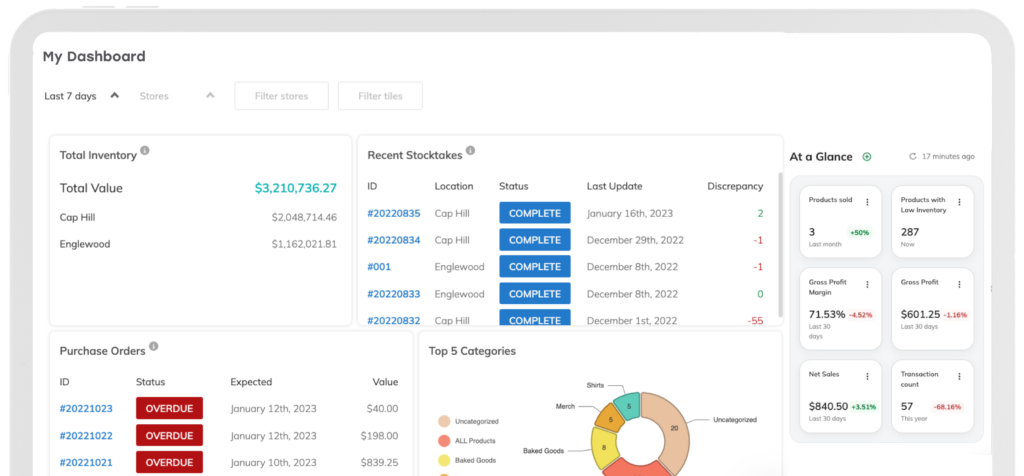
Product Bundling 101: How To Easily Sell More
Walk through just about any store, and you’ll likely see special deals where multiple products are sold together at a discount. That’s just one type of product bundling. This smart strategy boosts sales and enhances customer satisfaction by offering more value. It’s a great way to move inventory, too. Get started with product bundling.
Types Of Product Bundling
Pure product bundling
Pure bundling is when multiple products are sold exclusively as a package deal and can’t be purchased individually. Think of it like a skincare set with a cleanser, toner, and moisturizer, only available as a complete set.
Pure bundles are fantastic for reducing decision fatigue among customers, offering them a convenient all-in-one option. They also introduce customers to a full range of complementary products they might not have otherwise considered.
Mixed bundling
Mixed bundles offer the best of both worlds. Customers get the option to buy products individually or as part of a bundle. This flexibility caters to different customer preferences and helps boost sales by appealing to a broader audience.
For example, customers looking to pamper their mom for Mother’s Day might be struggling to decide between luxurious bath products and a relaxing face mask. Grouping these items in a Mother’s Day gift bundle means customers don’t have to worry about choosing.
Price bundling
Not all product bundles are about getting a discount. Price bundling, however, is.This bundling strategy offers a deal that’s too good to resist. With this approach, products are sold together at a lower price than if customers bought each item separately. A florist, for example, might offer a bundle deal that includes a bouquet of roses, a box of chocolates, and a handwritten card. This method encourages customers to buy more, giving them a sense of saving money while increasing your sales volume.
Benefits Of Product Bundling
- Cross-sell with ease. Product bundling is a great way to introduce customers to items they might not have considered otherwise. By grouping related products, you gently nudge customers toward trying new things that complement their initial purchase. Once they realize they like the product, you’ve brought on a new fan — and more sales.
- Increase average order value. Bundles encourage customers to spend more in a single transaction. Instead of just buying one item, they see the value in purchasing a set at a discounted price. This boosts your average basket size.
- Promote new products. When you’re launching a new item, bundling it with a best-seller puts it in the hands of more customers. This strategy leverages the popularity of established products to put new offerings in the spotlight.
- Move out slow-moving products. If you have some inventory that’s been sitting on the shelves for a while, bundling it with more popular products is a smart move. Pairing slow-moving products with bestsellers clears out old stock, prevents inventory waste, and makes room for new stock, ensuring your product lineup stays fresh and appealing to customers.
- Increase customer satisfaction. Shoppers love getting a good deal, so bundling products for a lower price enhances their shopping experience.
- Attract new customer segments. Customizing product bundles is a great way to bring new shoppers through the door. This approach appeals to bargain hunters looking for deals and fence-sitters who need a little extra incentive to buy.

8 Bundling Strategies Worth Trying
1. Complementary bundling
Complementary bundles pair products that naturally enhance each other, creating a more complete and satisfying experience for the customer. This strategy is effective for encouraging upsells and enhancing perceived value.
Consider a furniture store that adds in a throw blanket and a set of pillows when you buy a sofa. These complementary accessories enhance the value of the couch, further incentivizing customers to commit to the larger purchase. It also saves customers time by giving them a cohesive and stylish solution for their home decor needs without shopping somewhere else.
2. Cross-sell bundling
Cross-sell bundling involves combining a main product with something that complements it so well that you wouldn’t think of having one without the other. This strategy offers customers a more complete solution.
Imagine, for example, shopping for a new set of knives at a cookware shop. As a cross-sell offer, the store includes a knife sharpener to keep your new cutlery in top condition. This keeps your knives in new-like condition, extending the life of your utensils and increasing the value of your bundled purchase.
3. Tiered bundling
Tiered bundling offers different product groupings at varying price points, allowing you to meet a range of customer preferences. For instance, a hair care business might sell a basic bundle with shampoo and conditioner. Customers also have the choice of a deluxe bundle that adds a hair mask, or a premium bundle which includes a professional-grade styling tool. This strategy allows customers to choose the bundle that best suits their needs while increasing sales.
4. Mix-and-match bundling
Mix-and-match bundles let customers make their own package from a selection of products. A fashion retailer, for example, offers mix-and-match bundles where customers select any three items from a range of tops, bottoms, and accessories at a discounted price. This flexibility appeals to individual preferences and encourages larger purchases.
5. Price bundling
With price bundling, the total price of bundled items is less than the combined cost of purchasing each item individually. It’s about giving customers added value and convenience by offering a better deal when they buy multiple items together.
Take, for instance, a bike shop that bundles a commuter bike, a helmet, and a set of high-visibility lights at a lower price than buying each item separately. Many customers prefer this approach because, while they’re spending more money than if they only bought the bike, they get other biking essentials at a reduced price. For you, this means a higher average order value.

6. Seasonal bundling
Seasonal bundling involves tailoring packages to capitalize on trends, holidays, or special occasions throughout the year. This strategy is highly effective in appealing to customers’ seasonal preferences, driving sales during peak periods.
Consider a gardening supply store that sells a spring planting bundle that includes seeds, gardening tools, and fertilizer. These seasonal bundles encourage customers to purchase everything they need for their spring gardening projects in one convenient package.
7. Gift baskets
Position your products as the perfect present for any occasion. Whether it’s someone’s birthday or a heartfelt “thank you,” gift baskets offer a delightful mix of carefully chosen items that suit your customers’ tastes. They make it easy for gift-givers with a ready-made, impressive present that beautifully shows off your range of offerings.
Gift baskets aren’t limited to gourmet snacks or fruit. A spa boutique, for example, might offer gift bundles packed with candles, bath salts, organic skincare goodies, and a cozy robe. This assortment sells a pampering experience in an aesthetically pleasing package.
8. Subscription bundling
Subscription bundles let customers combine multiple subscription services into one convenient package. Consider, for example, a pet subscription box that bundles treats and toys for your furry friend, and even a few fun t-shirts and merchandise for the owner.
To bundle these subscriptions, the business offers a combined plan that features an assortment of products from each subscription box. When customers enroll in this plan, they regularly receive a curated selection of items tailored to their preferences and health goals. This approach ensures convenience for customers and promotes ongoing engagement and loyalty.

How To Promote Bundles
- Package them attractively. Make bundling a part of your retail merchandising strategy and put these items on display together. Think of each bundle like a gift—make it look irresistible. Invest in high-quality, eye-catching packaging or digital assets that show off all the goodies inside. Whether you’re selling product bundles online or at a brick-and-mortar store, a well-presented bundle grabs attention and enhances the perceived value to customers.
- Highlight their intended audience or purpose. Imagine your ideal customer and speak directly to their needs. Emphasize the benefits your target audience receives from purchasing these items together, and explain how they complement each other to fully satisfy customers’ needs and preferences. After all, if a customer buys a coffee grinder, how can they try out their exciting new kitchen gadget without gourmet coffee beans to go with it?
- Focus on the uniqueness of your bundle. Show customers why they should choose your bundle. Provide a detailed list of all included products. Break down each item and highlight what makes each stand out, whether it’s natural ingredients, innovative design features, or advanced technology, and explain why they’re better together. This approach helps customers understand exactly what they’re getting and why it’s valuable.
- Use data to inform your product bundling strategy. Analyze sales trends to see which products customers frequently purchase together or during specific seasons. Review customer feedback to understand their pain points, which helps you design bundles that meet their needs. Conducting market research is a great way to stay updated on industry trends and competitor offerings, ensuring your product bundles are competitive and appealing to your target audience.
- Highlight your bundles on product pages. Create a dedicated space for advertising your bundles on each product page related to the bundle. Use catchy banners, call-outs on your website, and compelling messaging in your buyer’s guide that highlights the benefits of purchasing items together. This way, customers exploring individual products will easily see the bundled options, increasing the chance that they’ll add more to their cart.

Product Bundling Challenges And How To Overcome Them
Even with the many perks of product bundling, there are some challenges you’ll need to be prepared to navigate. One potential issue is confusing customers by offering items both individually and as part of a bundle. For example, if someone only wants one item from a bundle but sees a better deal for buying everything together, they might hesitate, unsure if they’re getting the best value.
To tackle this challenge, provide clear options and pricing for individual items alongside bundled packages. You should also highlight the bundle’s added value and savings to encourage purchases without pressuring customers into buying more than they need.
What happens when customers are interested in only one item from a bundle? They might avoid purchasing the entire package, which leads to lost sales opportunities. To work around this potential hurdle, allow bundle customization based on customers needs. This way, they feel they’re getting value for their money without compromising on their preferences.
Customers might also perceive bundles as less valuable if they suspect you’re pairing products together to clear out slow-moving inventory or less popular items. That’s why it’s especially important to emphasize the quality and usefulness of each item in the bundle. Use customer testimonials to showcase positive experiences with the bundled products in addition to explaining how the bundle gives customers the best experience and results.

Tips For Successful Product Bundle Inventory Management
- Track all product materials. Keep a close eye on all the ingredients used in each bundle. If you make your products, it’s essential to know exactly what goes into each bundle and how much of each material you have in stock. This way, you’re always ready to restock, the quality of every product bundle stays the same, and you don’t run out of supplies for individual items.
- Create multiple price point options. Think of your bundles like a menu at your favorite restaurant — you want something for everyone. Offer bundles at multiple price levels to accommodate different budgets. Whether someone’s looking to splurge on the deluxe edition or stick to the essentials, having options makes it easier for them to say, “Yes, please!”
- Monitor bundle popularity and sales trends. Keep your finger on the pulse of what’s hot and what’s not. Tracking which product bundles are flying off the shelves and which ones could use a nudge helps you make the best decisions for adjusting your inventory strategy accordingly.
- Implement effective forecasting and replenishment strategies. Use historical sales data and demand planning tools to predict future sales trends for product bundling. This way, you maintain optimal inventory levels and avoid stockouts or overstock situations.
- Ensure seamless integration with inventory management systems. Make sure your product bundling strategy is reflected in your inventory management system. This ensures you accurately track bundled products, see your inventory levels in real time, and set a flow for efficient order fulfillment.
- Regularly review and update bundle offerings. Keep your bundle offerings fresh and appealing. Frequently reviewing your product bundles is the best way to make sure your offerings remain relevant to your customers while reducing the risk of excess inventory buildup.
Simplify Product Bundling With Thrive Inventory Management
Track complex inventory and component levels in real-time with product bundling. Costs and quantities are automatically calculated in real-time so you have accurate inventory counts throughout the day
See All The Benefits Of Bundling With Thrive Inventory
Adding product bundling to your sales strategy boosts customer satisfaction and drives sales. It also adds a layer of value and convenience that brings in more customers. As many benefits as bundling offers, it’s easy to get tangled up in managing all the inventory for your product bundles. That’s where Thrive Inventory comes in to help.
Thrive’s inventory management tools track every product detail so you know exactly what you have on hand and when to restock. There’s no need to worry about inventory woes anymore. Make Thrive Inventory your inventory management system, and turn your inventory challenges into a neatly wrapped package of profits.
The Newsletter For Small Businesses
Weekly expert insights, industry trends, and inspiring stories designed to help you run your business with confidence.
The Only Inventory System That Actually Helps You Run A Healthy Business
Thousands of customers all over the world use Thrive Inventory to run a healthy business.
Thrive Inventory gives you control over all your inventory, sales channels, and metrics, allowing you to make the right decisions at the right time.
Keep Reading

The Newsletter For Small Businesses
Weekly expert insights, industry trends, and inspiring stories designed to help you run your business with confidence.
Try Thrive Inventory For Free
Add Thrive Inventory to your business and maximize your potential. With powerful and easy-to-use products, it’s time to take control of
your business and see what you can do with Thrive.




